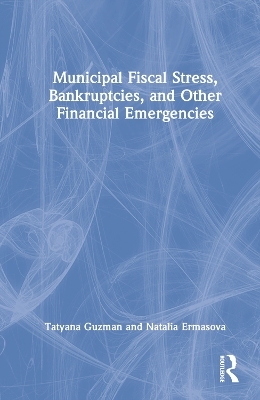
Municipal Fiscal Stress, Bankruptcies, and Other Financial Emergencies
Routledge (Verlag)
978-1-032-34937-4 (ISBN)
It is di□fficult to find someone who has not heard about the Puerto Rico, Detroit, Michigan, or Orange County, California, bankruptcies. While guides for responsibly managing government finances exist, problems often originate not because of poor financial reporting or financial deficiencies but because issues external to financial wellbeing arise, such as economic, demographic, political, legal, or even environmental factors. Exacerbating the problem, there is not much advice in the existing literature on how to act when municipalities face financial struggles. Filling this important gap, this book explores fiscal health and fiscal hardships, municipal defaults and bankruptcies, and many other aspects to help guide local governments during fiscal distress.
Fiscal hardships negatively affect the quality and availability of public goods and services and, consequently, the wellbeing of residents and businesses living and working in distressed municipalities. Turned off streetlights, unmaintained public parks, potholes, inconsistent garbage pickup, longer response time from emergency services, and multiple other issues that residents of the struggling municipalities deal with, lead to higher crime rates, lower quality of K-12 education, dangerous road conditions, lower housing values, outmigration of wealthier population, and numerous other problems. The COVID-19 pandemic put additional unprecedented pressure on municipal finances nationwide.
In this book authors Tatyana Guzman and Natalia Ermasova evaluate distressed cities and municipalities and provide practical recommendations on improving their financial conditions. What are conditions and signs to look for to not to find yourself in similar situations? What can be done if your municipality is already experiencing fiscal hardships? What are the consequences of fiscal misfortunes? How does one exit a fiscal emergency? This book answers these and other questions and serves as a guide to fiscal health and prosperity for U.S. municipal governments, students and researchers in public finance, and general public management fields.
Tatyana Guzman is Associate Professor in public finance and policy analysis at Cleveland State University. Dr. Guzman received her PhD in public affairs from O’Neill School of Public and Environmental Affairs at Indiana University and also holds an MA degree in economics. Dr. Guzman's primary research interests are in various aspects of the public finance field, including taxation, budgeting, and municipal bond markets. She has published over 20 journal articles and book chapters. Her research has appeared in such peer-reviewed journals as Public Budgeting and Finance (PBF), Policy Studies Journal (PSJ), American Review of Public Administration (ARPA), Journal of Benefit-Cost Analysis (JBCA), Tax Notes, and other outlets. Tatyana has 15 years of teaching experience at Cleveland State University, Indiana University Bloomington (IUB), and Indiana University Purdue University in Indianapolis (IUPUI), where she has taught undergraduate and graduate public finance and budgeting, research methods, economics, and statistics courses. Natalia Ermasova is a Professor at Governors State University, Illinois, USA. She has a PhD in public affairs (SPEA, Indiana University, USA). Her primary research interests are capital budgeting, business ethics, public finance, leadership, risk-management, innovation management, and public education funding. She was Visiting Professor in Germany (Ludwigsburg Academy for Civil Services), Corvinus University (Hungary) and Fulbright Visiting Professor (SPEA, IU). Dr. Natalia Ermasova is a board member of the International Journal of Public Administration (IJPA) and Co-Editor of Global Encyclopedia of Public Administration, Public Policy, and Governance. More than 60 of her articles, books, and chapters were published in the USA, UK, and Australia. She is the author of six textbooks about budgeting systems, financial management, and risk-management. Her articles have been published in journals including Public Finance and Management, State and Local Government Review, the International Journal of Public Administration, and the Journal of Management Development.
1. Introduction 2. Municipal Fiscal Health 3. Preventative Treatment and Federal, State, and Local Incentives for Unhealthy Municipalities 4. Legal Aspects of Municipal Bankruptcy 5. Fiscal Stress and Operating Budget 6. Fiscal Stress and Capital Infrastructure 7. Fiscal Stress During the Covid-19 Pandemic 8. Introduction to the Case Studies 9. Case Study #1. City of Detroit 10. Case Study #3 of Colorado Spring, CO 11. Case Study #4 Jefferson County, Alabama 12. Case Study #5 Pittsburgh, Pennsylvania 13. Case Study #7 Central Falls, Rhode Island 14. Case Study #8 Vallejo, California 15. Conclusions and a theory of financial management and budgeting during fiscal emergency and bankruptcy
| Erscheinungsdatum | 11.11.2022 |
|---|---|
| Zusatzinfo | 29 Tables, black and white; 3 Line drawings, black and white; 21 Halftones, black and white; 24 Illustrations, black and white |
| Verlagsort | London |
| Sprache | englisch |
| Maße | 152 x 229 mm |
| Gewicht | 730 g |
| Themenwelt | Sozialwissenschaften ► Politik / Verwaltung ► Staat / Verwaltung |
| Wirtschaft ► Betriebswirtschaft / Management ► Planung / Organisation | |
| Wirtschaft ► Volkswirtschaftslehre | |
| ISBN-10 | 1-032-34937-9 / 1032349379 |
| ISBN-13 | 978-1-032-34937-4 / 9781032349374 |
| Zustand | Neuware |
| Haben Sie eine Frage zum Produkt? |
aus dem Bereich


